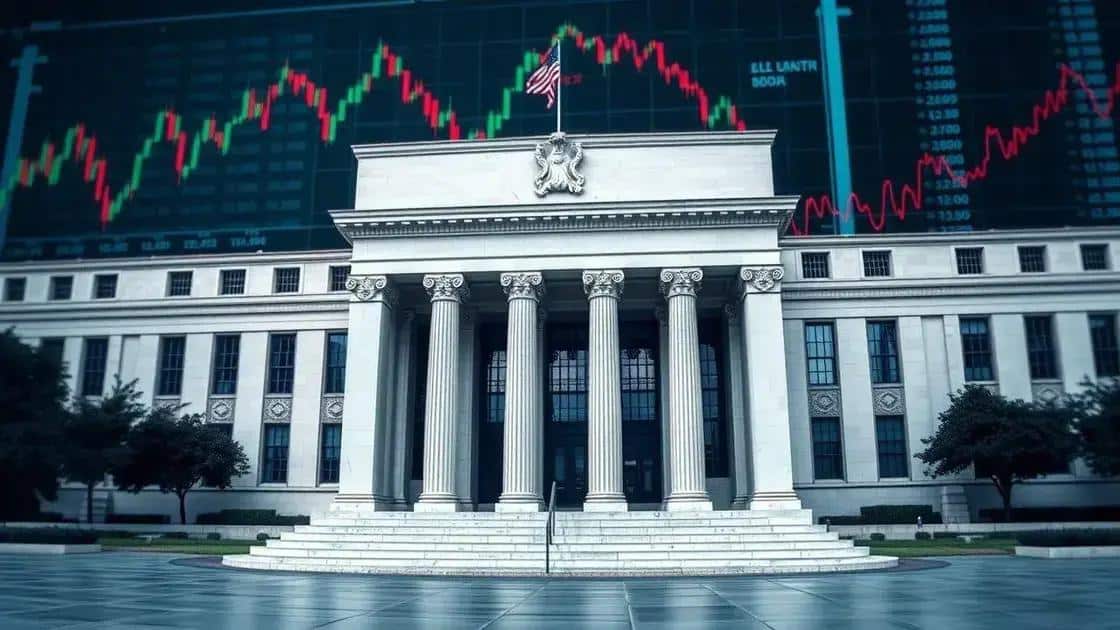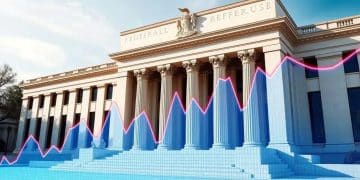Top Federal Reserve interest rate changes impact analysis

Changes in interest rates directly impact consumer behavior by influencing borrowing costs, spending habits, and savings patterns, ultimately shaping economic growth and market dynamics.
Top Federal Reserve interest rate changes can significantly influence both financial markets and everyday life. Have you ever wondered how these changes impact your savings or loans? In this article, we will analyze the effects of these crucial decisions.
Understanding the Federal Reserve’s role in the economy
The Federal Reserve plays a critical role in shaping the U.S. economy. As the central bank, it manages monetary policy, which influences inflation, unemployment, and overall economic growth. But how does it accomplish this? Let’s explore the various mechanisms the Federal Reserve uses to maintain economic stability.
Monetary Policy Tools
The Federal Reserve utilizes several important tools to control the money supply and interest rates. Understanding these tools is key to grasping how they influence our economy.
- Open Market Operations: This involves buying or selling government securities to adjust the amount of money in the banking system.
- Discount Rate: The interest rate at which banks can borrow from the Fed. Changing this rate can impact lending.
- Reserve Requirements: The amount of funds banks must hold in reserve. Lowering reserve requirements allows banks to lend more.
These tools work together to regulate the economy. For example, when the economy is slowing down, the Fed may lower interest rates. This encourages borrowing and investing, which can help stimulate growth.
Inflation and Employment
Another vital function of the Federal Reserve is targeting inflation and optimizing employment rates. The Fed aims for a low and stable inflation rate, typically around 2%. By controlling inflation, the Fed helps ensure that the purchasing power of money remains stable over time.
When the economy is growing too fast, the Fed may raise interest rates. This helps to cool down inflation but can slow economic growth. On the other hand, if unemployment is high, the Fed may decide to lower rates to encourage borrowing and expand job opportunities. Balancing these factors is crucial for economic health.
In conclusion, the Federal Reserve impacts our lives more than we might realize. By managing money supply and interest rates, it influences everything from job creation to prices at the store. Understanding its role helps us navigate our personal finances and the broader economic landscape.
Key historical interest rate changes and their outcomes
Understanding the key historical interest rate changes helps us see how these decisions affect the economy. The Federal Reserve has made critical adjustments over the years that have shaped economic growth and employment.
The 1980s Volcker Shock
One of the most notable instances occurred in the late 1970s and early 1980s. Paul Volcker, Chairman of the Federal Reserve, faced soaring inflation. To combat this, he raised interest rates dramatically, peaking at over 20% in June 1981. This bold move successfully reduced inflation but also led to a recession. The impact of this policy saw a return to stability in the long term.
The 2008 Financial Crisis
Fast forward to 2008, another crucial period for interest rate adjustments. As the financial crisis unfolded, the Federal Reserve slashed rates to near zero. This significant reduction aimed to stimulate borrowing and revive the economy. The near-zero rates persisted for several years, leading to an extended period of economic recovery.
- Immediate goal: Restore lending and consumer confidence.
- Long-term consequence: Concerns about asset bubbles due to low borrowing costs.
- Impact on average consumers: More accessible loans and lower credit costs.
During this time, the Fed also introduced programs such as quantitative easing, further increasing the money supply to support economic growth. These actions demonstrated how interest rate changes could stimulate or restrain economic activity.
Recent Trends and Changes
In recent years, the Federal Reserve has gradually increased interest rates to combat inflation, particularly in the wake of the recovery from the pandemic. Each rate hike influences consumer borrowing and spending. In 2022, when faced with rising inflation, the Fed returned to aggressive rate increases to stabilize prices.
The impact of these decisions is visible in everyday life. For example, higher interest rates can lead to increased mortgage costs and affect consumer spending. Understanding these shifts provides valuable insight into how personal finance is shaped by the Fed’s policies.
Current trends in interest rates and market reactions

Current trends in interest rates reflect significant shifts in the economic landscape. Understanding these trends helps us see how they impact markets and consumers alike. As the Federal Reserve adjusts rates, the effects are felt on various fronts.
Recent Interest Rate Increases
Recently, the Federal Reserve has been raising interest rates in response to soaring inflation. This decision aims to curb spending and bring prices under control. With this adjustment, the borrowing costs for consumers and businesses have increased.
- Home Mortgages: Rising rates lead to higher monthly payments, which can cool down the housing market.
- Car Loans: Higher interest can discourage consumers from financing new vehicles, affecting auto sales.
- Credit Cards: Increased rates mean more expensive debt, impacting consumer budgets.
Investors closely monitor these changes. As rates rise, the stock market often reacts, leading to volatility. Higher rates can make bonds more attractive compared to stocks, leading to shifts in investment strategies.
Market Reactions
The stock market typically responds negatively to rising interest rates. Investors fear that increased borrowing costs will reduce corporate profits. Consequently, sectors like technology, which rely heavily on growth through borrowing, often experience declines.
However, some sectors may benefit from higher rates. For instance, financial institutions like banks tend to perform better when interest rates rise. They can charge more for loans compared to the interest they pay on deposits. This environment can enhance their profit margins.
In the long term, these trends are critical. They influence everything from job growth to consumer confidence. As interest rates fluctuate, they play a pivotal role in shaping the economic outlook for businesses and individuals.
How interest rate changes affect consumer behavior
Interest rate changes have a profound impact on consumer behavior. When the Federal Reserve adjusts rates, it affects how individuals and families make financial decisions. Understanding these effects is crucial for managing personal finances effectively.
Borrowing Costs
When interest rates rise, the cost of borrowing increases. This shift makes loans, such as mortgages and personal loans, more expensive. As a result, many consumers may delay or reconsider major purchases. For example, potential homebuyers might hold off on buying a house if they know that mortgage rates are climbing.
- Housing Market: Higher mortgage rates often lead to reduced demand for homes.
- Auto Sales: Increased loan costs can make financing a new car less appealing.
- Credit Card Debt: As rates climb, carrying a balance can become more costly.
As borrowing becomes more expensive, consumers tend to tighten their budgets, cutting back on discretionary spending. This can have a ripple effect throughout the economy, slowing growth in various sectors.
Saving Incentives
On the other hand, higher interest rates can encourage saving. When rates increase, banks often offer better returns on savings accounts and certificates of deposit (CDs). Consumers might choose to save more money rather than spending it.
This behavior can lead to a shift in financial priorities. People may focus on building their savings rather than making purchases. As they accumulate savings, they prepare for potential future expenses or investments.
Overall, interest rates influence not just borrowing and spending, but also saving patterns. Understanding how these changes impact consumer behavior helps individuals make informed financial decisions. As rates fluctuate, consumers adapt their habits, reflecting their responses to the broader economic conditions.
Future outlook for interest rates and economic implications
The future outlook for interest rates is a key concern for many. As the Federal Reserve continues to evaluate economic conditions, their decisions will have lasting implications for individuals and businesses alike. Understanding potential scenarios can help consumers make better financial choices.
Predicted Rate Adjustments
Many analysts believe that the Federal Reserve will adjust interest rates based on inflation and economic growth. If inflation continues to rise, the Fed may increase rates further. This could help stabilize prices, but it could also slow down economic growth.
- Impact on Borrowing: Higher rates can make loans more expensive, affecting mortgages and car loans.
- Consumer Spending: As borrowing costs rise, consumers may reduce spending, leading to slower growth.
- Savings Rates: A potential upside is better returns on savings accounts, encouraging consumers to save more.
On the other hand, if the economy shows signs of weakness, the Fed may lower rates to stimulate growth. Lower rates can boost borrowing and spending, which can help lift the economy during downturns.
Economic Implications
The economic implications of interest rate changes are significant. For instance, business investments often depend on borrowing costs. If rates rise, companies may delay or scale back their expansion plans. This can have a cascading effect, potentially leading to slower job growth.
Additionally, fluctuations in interest rates can influence stock market performance. Investors often seek to balance their portfolios based on rate expectations. As interest rates change, some sectors may see more volatility than others.
In conclusion, monitoring the Fed’s decisions will be essential for navigating future economic conditions. The interplay between interest rates and various economic factors highlights the need for consumers and businesses to stay informed and adapt their strategies accordingly.
FAQ – Frequently Asked Questions about Interest Rates and Their Impact
What are interest rates?
Interest rates are the cost of borrowing money or the return on savings, expressed as a percentage.
How do interest rate changes affect home mortgages?
When interest rates rise, mortgage costs increase, making home buying less affordable for many consumers.
What impact do rising interest rates have on consumer spending?
Higher interest rates often lead consumers to spend less, as loans become more expensive and budgets tighten.
How can consumers prepare for future interest rate changes?
Consumers can stay informed about economic trends, adjust their budgets, and consider locking in lower rates for loans.






